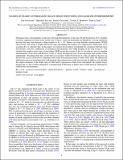| dc.contributor.author | Johannsen, Tim | |
| dc.contributor.author | Psaltis, Dimitrios | |
| dc.contributor.author | Gillessen, Stefan | |
| dc.contributor.author | Marrone, Daniel P. | |
| dc.contributor.author | Fish, Vincent L. | |
| dc.contributor.author | Doeleman, Sheperd Samuel | |
| dc.contributor.author | Ozel, Feryal | |
| dc.date.accessioned | 2015-02-25T13:10:46Z | |
| dc.date.available | 2015-02-25T13:10:46Z | |
| dc.date.issued | 2012-09 | |
| dc.date.submitted | 2011-12 | |
| dc.identifier.issn | 0004-637X | |
| dc.identifier.issn | 1538-4357 | |
| dc.identifier.uri | http://hdl.handle.net/1721.1/95499 | |
| dc.description.abstract | Dynamical mass measurements to date have allowed determinations of the mass M and the distance D of a number of nearby supermassive black holes. In the case of Sgr A*, these measurements are limited by a strong correlation between the mass and distance scaling roughly as M ~ D [superscript 2]. Future very long baseline interferometric (VLBI) observations will image a bright and narrow ring surrounding the shadow of a supermassive black hole, if its accretion flow is optically thin. In this paper, we explore the prospects of reducing the correlation between mass and distance with the combination of dynamical measurements and VLBI imaging of the ring of Sgr A*. We estimate the signal-to-noise ratio of near-future VLBI arrays that consist of five to six stations, and we simulate measurements of the mass and distance of Sgr A* using the expected size of the ring image and existing stellar ephemerides. We demonstrate that, in this best-case scenario, VLBI observations at 1 mm can improve the error on the mass by a factor of about two compared to the results from the monitoring of stellar orbits alone. We identify the additional sources of uncertainty that such imaging observations have to take into account. In addition, we calculate the angular diameters of the bright rings of other nearby supermassive black holes and identify the optimal targets besides Sgr A* that could be imaged by a ground-based VLBI array or future space-VLBI missions allowing for refined mass measurements. | en_US |
| dc.description.sponsorship | National Science Foundation (U.S.) (Grant AST-0908731) | en_US |
| dc.description.sponsorship | National Science Foundation (U.S.) (Grant AST-0905844) | en_US |
| dc.description.sponsorship | National Science Foundation (U.S.) (Grant AST-0807843) | en_US |
| dc.language.iso | en_US | |
| dc.publisher | IOP Publishing | en_US |
| dc.relation.isversionof | http://dx.doi.org/10.1088/0004-637x/758/1/30 | en_US |
| dc.rights | Article is made available in accordance with the publisher's policy and may be subject to US copyright law. Please refer to the publisher's site for terms of use. | en_US |
| dc.source | American Astronomical Society | en_US |
| dc.title | MASSES OF NEARBY SUPERMASSIVE BLACK HOLES WITH VERY LONG BASELINE INTERFEROMETRY | en_US |
| dc.type | Article | en_US |
| dc.identifier.citation | Johannsen, Tim, Dimitrios Psaltis, Stefan Gillessen, Daniel P. Marrone, Feryal Ozel, Sheperd S. Doeleman, and Vincent L. Fish. “MASSES OF NEARBY SUPERMASSIVE BLACK HOLES WITH VERY LONG BASELINE INTERFEROMETRY.” The Astrophysical Journal 758, no. 1 (September 21, 2012): 30. © 2012 The American Astronomical Society | en_US |
| dc.contributor.department | Haystack Observatory | en_US |
| dc.contributor.mitauthor | Doeleman, Sheperd Samuel | en_US |
| dc.contributor.mitauthor | Fish, Vincent L. | en_US |
| dc.relation.journal | The Astrophysical Journal | en_US |
| dc.eprint.version | Final published version | en_US |
| dc.type.uri | http://purl.org/eprint/type/JournalArticle | en_US |
| eprint.status | http://purl.org/eprint/status/PeerReviewed | en_US |
| dspace.orderedauthors | Johannsen, Tim; Psaltis, Dimitrios; Gillessen, Stefan; Marrone, Daniel P.; Ozel, Feryal; Doeleman, Sheperd S.; Fish, Vincent L. | en_US |
| mit.license | PUBLISHER_POLICY | en_US |
| mit.metadata.status | Complete | |
